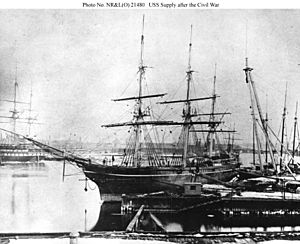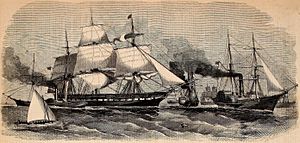USS Supply (1846) facts for kids

USS Supply, probably at the New York Navy Yard after the Civil War
|
|
Quick facts for kids History |
|
|---|---|
| Name | USS Supply |
| Acquired | 1846 |
| Commissioned | 19 December 1846 |
| Decommissioned | 17 December 1848 |
| Recommissioned | 17 February 1849 |
| Decommissioned | 7 July 1870 |
| Recommissioned | 21 February 1871 |
| Decommissioned | 23 April 1879 |
| Fate | Sold 3 May 1884 |
| General characteristics | |
| Type | Sailing ship |
| Tonnage | 547 |
| Speed | 11.5 knots (21.3 km/h; 13.2 mph) |
| Complement | 40 officers and enlisted men |
| Armament | 4 × 24-pounder (10.9-kg) guns |
The first USS Supply was a large sailing ship used by the United States Navy. She was a stores ship, meaning she carried supplies for other ships. Supply played a role in two major conflicts: the Mexican–American War and the American Civil War.
Contents
Supply was bought by the U.S. Navy in Boston, Massachusetts, in late 1846. This was during the Mexican–American War. She was officially ready for service on December 19, 1846. Lieutenant John Calhoun was her first commander.
Mexican–American War Service
On January 21, 1847, Supply sailed to the Gulf of Mexico. Her job was to bring supplies to the Home Squadron, a group of U.S. Navy ships fighting in the war against Mexico. She helped support these operations until the summer. Then, she returned to New York City on September 26, 1847.
Exploring the Dead Sea
Just two months later, on November 26, 1847, Supply set sail again. This time, Lieutenant William F. Lynch was in command. She was carrying equipment and supplies for an expedition to explore the Dead Sea in the Middle East.
After stopping in Gibraltar and Port Mahón, she faced a two-week delay. Two cases of smallpox on board meant the ship had to stay in quarantine. Once cleared, she continued her journey.
On February 16, 1848, Supply reached Smyrna in the Ottoman Empire. Lieutenant Lynch left the ship there. He traveled to Constantinople to get permission from Sultan Abdulmejid I for the expedition. He returned on March 11, 1848. After some bad weather delays, the ship finally sailed to Syria. She arrived in Beirut on March 25, 1848. The exploration team then left the ship to travel to the Jordan River and the Dead Sea. Lynch's detailed report from this trip was still used as a key source of information decades later.
Supply cruised around the Mediterranean Sea while the team was away. When she returned in August 1848, she learned the expedition was a success. Lynch and his team, tired and unwell, had chartered another ship to take them to Malta. Supply then picked them up in Malta on September 11, 1848. She brought them back to the United States, arriving in Norfolk, Virginia, on December 8, 1848. She was taken out of service shortly after.
Tripoli and Japan Missions
Supply was put back into service on February 17, 1849. She sailed to the Mediterranean again, carrying the United States consul to Tripoli. After dropping off her passenger and delivering supplies, she returned home via Brazil. She arrived in Norfolk on September 4, 1849.
In November 1849, Supply was reactivated. In January 1850, she sailed around Cape Horn to California. This was during the California Gold Rush, and the coast was busy with people looking for gold.
Two years later, she returned to New York. She was then assigned to the East India Squadron. Her job was to support Commodore Matthew C. Perry's famous expedition to Japan. She entered Edo Bay on March 19, 1854, during Perry's second visit to Japan. After serving off the coast of China, she returned to New York in February 1855.
The Camel Corps Experiment
Supply's next mission was very unusual. United States Secretary of War Jefferson Davis wanted to explore the desert lands the U.S. had gained from Mexico. He thought camels might be useful for travel in these areas. So, he arranged for an experiment to create a United States Army Camel Corps.
Supply, commanded by Lieutenant David Dixon Porter, left New York on June 4, 1855. She sailed to the Mediterranean to get the camels. On January 30, 1856, she reached Smyrna in the Ottoman Empire. She loaded 21 camels (some reports say 31) and sailed for the Gulf of Mexico on February 15, 1856. Porter delivered the animals to Indianola, Texas, in May 1856. Supply then went back to the Levant for another group of camels. She transferred these to another ship on the Mississippi River in February 1857.
Paraguay Expedition and Civil War
After the camel missions, Supply joined a special squadron. This group was sent to South America to help settle a dispute between the United States and Paraguay. Paraguayans had fired on a U.S. Navy gunboat. Supply arrived off Asunción, Paraguay, on January 25, 1859. Her presence helped in the talks, which ended with Paraguay apologizing and paying for the incident.
Supply then served with the Africa Squadron and along the East Coast of the United States and in the Gulf of Mexico.
Service During the Civil War
In January 1861, as Southern states began to leave the Union, Supply was in Pensacola Bay, Florida. On January 16, 1861, she sailed north. She carried the families and belongings of officers and men from the Pensacola Navy Yard. She arrived in New York on February 4, 1861.
The ship sailed south again on March 15, 1861, carrying U.S. Army and Marine troops. She anchored in Pensacola, Florida, harbor on April 7, 1861. On April 11, 1861, she secretly landed these troops at night to strengthen Fort Pickens. The American Civil War officially began the next day. Confederate forces opened fire on Fort Sumter in South Carolina.
Throughout the Civil War, Supply supported the Union blockade. This blockade aimed to stop supplies from reaching the Confederate states. She worked along the United States East Coast and in the Gulf of Mexico. On January 29, 1862, she captured her only prize of the war. She seized the schooner Stephen Hart, which was carrying weapons and ammunition, south of Sarasota, Florida. Supply's steady work, though not always exciting, allowed other warships to stay on duty. This helped to shorten the war.
Post-War Service and Final Years
After the Civil War ended, Supply continued her service. In 1866, she was part of the Brazil Squadron. In 1867 and 1868, she served in the Far East. She was then taken out of service for a period. On July 7, 1870, she was officially decommissioned in New York.
On February 21, 1871, Supply was put back into service. She sailed across the Atlantic Ocean carrying supplies for the people of France. They had suffered greatly during the Franco-Prussian War. In the spring of 1872, she carried a new crew to another ship in the South Atlantic Squadron. The next year, she transported American exhibits to Austria-Hungary for the Vienna Exposition of 1873.
After two years of rest in New York, she returned to Europe to bring the exhibits back from Vienna. Later that year, she took boys from New York on a training cruise. In 1877, she served as a tender (a support ship) for the training ship Minnesota.
In 1878, Supply sailed to Europe again. She carried American exhibits for the Paris Exposition of 1878. She brought them home in March 1879. During this trip, on October 26, 1878, off Le Havre, France, a brave sailor named John Flannagan saved a shipmate from drowning. He was later given the Medal of Honor for his bravery.
On January 27, 1879, Supply was involved in a collision with a British ship called Diadem in the Atlantic Ocean. The crew of Diadem had to leave their ship and were taken to Madeira.
Supply was decommissioned for the final time in New York on April 23, 1879. She was then towed to Philadelphia, Pennsylvania. She remained there until she was sold on May 3, 1884, to M. H. Gregory of Great Neck, Long Island, New York.


